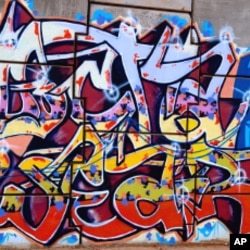Graffiti art in Senegal's capital city is fast becoming a popular and socially accepted way for a young generation eager to speak out. Graffiti in Dakar can be considered a tool for development, rather than a pointless form of vandalism.
Below a cement overpass leading into downtown Dakar is a bright pink, 88-foot graffiti mural. Every day hundreds of cars whip by giving drivers and passengers quick glimpses of two historically renowned African figures: Senegalese scholar Cheikh Anta Diop facing opposite revolutionary leader Amilcar Cabral. Between the two icons is a white banner with the words "Unity in Diversity" written in large block letters. The bottom left is simply signed: Docta.
Over 20 years ago, at around the same time that hip-hop culture was making its way across the Atlantic from the United States, a young Senegalese teenager started using the bleak public walls of Dakar as his personal canvas. Docta, whose real name is Amadou Lamine Ngom, is known as the "pioneer of graffiti art" in Senegal.
Docta says in the beginning Senegalese did not understand this new art form. They did not know who did it or when they did it, because like all good graffiti artists he worked at night in places, illegally, where it was really rundown, where people urinated or threw their garbage.
Docta says people were confused by his work, because at the time it was more artistic. But at one point he had to simplify the messages so that people could read and understand what he was saying.
Docta says in African countries, graffiti artists are all inspired by the same feeling and the same sense of duty. They are all living the same difficulties, socially and politically.
At his annual Festigraff festival both African and international artists have a chance to share what unites them: the need to talk to the people, to educate and to defend people's rights. Docta says they are all fighting for the population, and while doing this they are also fighting for themselves.
The images and words they use represent their history, their daily struggles, what the system imposes, and how people should behave. Docta says the true role of graffiti artists in Senegal is to use their work as a trampoline of communication between urban art and the population.
Professor Abdoulaye Niang is a sociologist and researcher who specializes in graffiti art and urban hip-hop culture at Gaston Berger University in Senegal.
Niang says hip-hop graffiti artists use graffiti and writing for an aesthetic reason, to fill some social and cultural function or to serve a political purpose. In the same way that rappers are representing the masses, or present themselves as the "voice of the voiceless," graffiti 'writers' subscribe to the same movement.
Niang says there are some artists who believe that it is not graffiti unless they steal their spray guns or paint where it is not allowed. The need to rebel is a fundamental value in graffiti, it is a rebellion against authority. But this aspect is more relevant in Western countries, says Niang. In Senegal, what is most important is that their work is visible.
Docta is combining graffiti art with health awareness, painting murals in some of Dakar's poorest neighborhoods with messages in Wolof, such as "health has no price." Local doctors are invited to come out, un-uniformed, to provide free AIDS and diabetes testing and to give consultations and medication.
Docta says that while in the beginning the goal of graffiti was to revolt, now he realizes he has to bring something to the population. They can't just say no, it is not going well. They also have to bring forward solutions. They are not doctors, but they can still help by working with those who are.
Docta says most Senegalese have an aversion to going to hospitals, because they think the medical staff is rude or the drugs are too expensive. Docta says graffiti artists can encourage the population and doctors to come together in the street, a neutral space where locals feel less intimidated.
Graffiti in Senegal, like in most parts of the world, is illegal. But unlike in many Western countries, and even some African ones, the likelihood of an artist in Senegal being arrested for graffiti is very slim.
Professor Niang says people here are more likely to accept graffiti because they see it more as beauty than vandalism. He says graffiti is a way for young people to express themselves in a society that still has strong respect for its elders, moving from the margins to the center of decision-making by spreading messages and becoming opinion leaders.
Docta says graffiti artists are actually very social people, but they are also humble and simple individuals who really just want to share and are always learning. Every fresco gives birth to another, he says. It demands that the artist is constantly on the lookout for new discoveries and new points of views. It is only by doing this that they are able to envision a future different from the one they are currently living.












